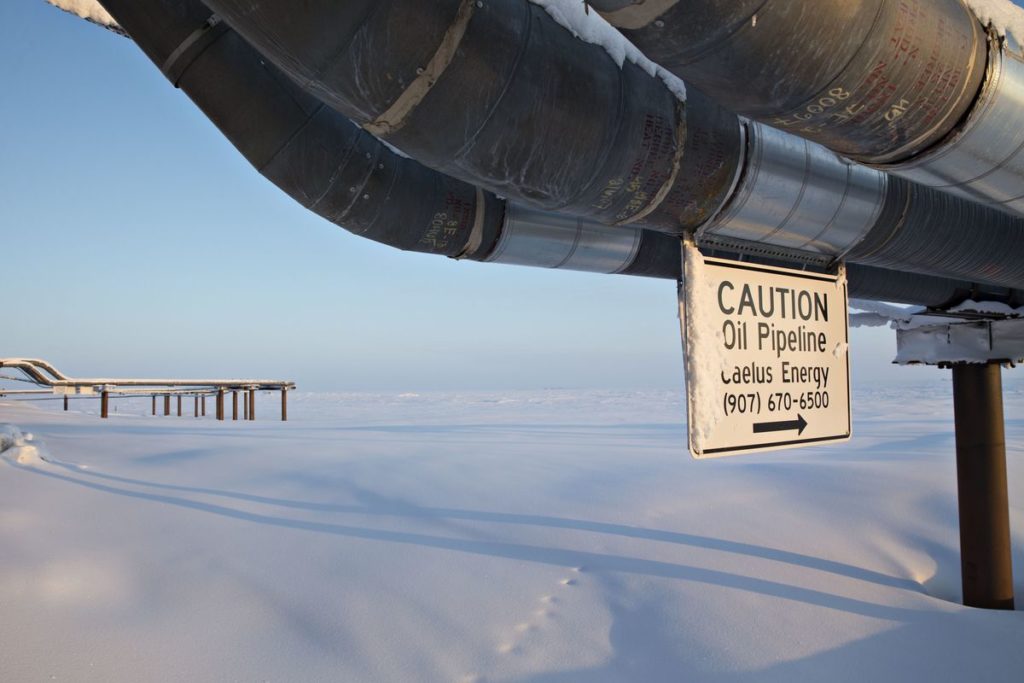
The Trump administration outlined plans for selling drilling rights on every acre of the Arctic National Wildlife Refuge’s coastal plain, despite acknowledging potential oil spills and impacts to polar bear and caribou that roam through the region.
The Interior Department’s draft environmental impact statement, published online Thursday, is a major milestone in the administration’s push to sell drilling rights in the refuge as soon as 2019. It lays out four approaches to leasing the land for oil development, including one option that would forgo the activity altogether and two that envision putting the entire coastal plain –about 1.56 million acres — up for grabs.
Environmentalists blasted the move, saying the analysis was rushed by the Trump administration in its bid to jump-start drilling, resulting in a report that gave short shrift to the potentially lethal consequences of oil development on wildlife.
“In their rush to drill for oil in the Arctic National Wildlife Refuge at all costs,” the Trump administration “is sidelining science, public input and the health of polar bears, caribou, and other wildlife,” said Matt Lee-Ashley, senior fellow at the liberal Center for American Progress.
Energy Security
Supporters argued that oil development in the refuge’s coastal plain would deliver a boost to U.S. energy security, as well as a new source of crude for the 800-mile (1,287 kilometer) Trans-Alaska Pipeline System that could help preserve its viability amid declining North Slope production.
“An energy-dominant America starts with an energy-dominant Alaska,” said Interior Secretary Ryan Zinke, who’s resigning from his post at year-end.
The U.S. government is required to hold at least two auctions of oil and gas leases in the coastal plain within a decade, under a law Congress passed last December which ended a decades-long ban on energy development in the region. Trump administration officials are aiming to hold the first of those sales in 2019.
The Interior Department’s Bureau of Land Management said its first sale would make at least 400,000 acres available for oil drilling. Two of the three outlined leasing plans would make the entire coastal plain available, though one would put more limits on where oil and gas companies can conduct above-ground work.
Porcupine Caribou
That third, more restrictive option would keep at least 476,600 acres of porcupine caribou herd calving habitat off limits, but still make 66 percent of the coastal plain available for oil and gas development.
Assistant Interior Secretary Joe Balash stressed that all of the options include protections for the porcupine caribou, a wide-roaming species whose conservation is co-managed by Canada and the U.S.
Despite Congress’ mandate, the Interior Department’s Bureau of Land Management must conduct environmental reviews of potential oil development in the refuge, and expected lawsuits may slow the government’s timeline. Even after oil companies buy leases in the region, future drilling efforts would require separate permits and authorizations.
The Interior Department is separately considering a bid by Houston-based SAExploration Holdings Inc. to conduct seismic surveys in the region to help pinpoint potential oil and gas resources. Consideration of that proposal has slowed amid concerns about potential harm to polar bears, which are listed as threatened with extinction under the Endangered Species Act and would be hidden in snow-covered dens when the work is conducted.
Polar Bears
All of the government’s plans to allow leasing would affect polar bears in the region. And conservationists said the analysis overlooks potential harm to the animals, including the risk that obscured dens are crushed by equipment, killing the bears inside.
Opponents argue drilling threatens to forever alter the pristine wilderness populated with arctic foxes, polar bears, caribou herds, migratory birds and other species.
“The Arctic refuge is an amazing, beautiful, wild landscape” that’s home to an array of special animals, said Nicole Whittington-Evans, Alaska regional director of The Wilderness Society. In the administration’s zeal to expand oil drilling, “they are reaching into a treasured, iconic wilderness refuge.”
Read more: Low oil prices dim GOP bid for budget bonanza in Arctic
Any oil resources on the coastal plain would be relatively expensive to extract and bring to market, requiring the construction of new pipelines and other infrastructure, though companies could take advantage of existing infrastructure on Alaska’s North Slope. ConocoPhillips, Exxon Mobil Corp. and BP Plc all have operations in the nearby Prudhoe Bay oil field.
It’s not clear how much enthusiasm companies would have for nabbing territory in the region amid the current oil price slump, though a big potential prize is beckoning. Geological surveys hint of large underground formations with the potential for monster discoveries that could produce oil for decades. The U.S. Geological Survey has estimated that ANWR’s coastal plain might hold between 4.3 billion and 11.8 billion barrels of technically recoverable crude.
“There aren’t very many basins in the planet where we have a very high degree of confidence that there’s significant hydrocarbons that haven’t been explored yet,” Balash said. “There’s going to be, we expect, significant industry interest in being a part of finding out what’s there and having a place in line for producing it.”
Recommended for you
